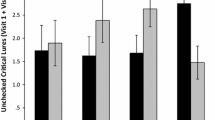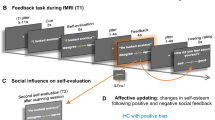Abstract
This study examined whether individuals with social anxiety disorder have a memory bias for bodily sensations associated with anxiety. Using a false feedback paradigm, 33 individuals with social anxiety disorder (SAD) and 34 non-anxious control (NAC) participants completed a performance task while monitoring stimuli they were told provided feedback on whether their physiological response was changing or stable. On measures of free recall and recognition for their feedback no differences were found between SAD and NAC individuals. However, among SAD participants only, fear of bodily sensations was significantly associated with enhanced memory for stimuli associated with physiological responses. Results suggest that research and treatment may benefit from considering not only fear of social situations, but also the focus of those fears, such as bodily sensations, when examining memory biases in social anxiety.
Similar content being viewed by others
Notes
In Quebec students are required to complete a pre-university college which is the equivalent of the final 2 years of high school in other parts of Canada and the United States.
Results pertaining to the predictions of the study did not change when analyses were rerun excluding the two SAD participants meeting diagnostic criteria for substance dependence without physiological dependence and the two NAC participants who reporting taking psychotropic medication.
References
Alden, L. E., Teschuk, M., & Tee, K. (1992). Public self-awareness and withdrawal from social interactions. Cognitive Therapy and Research, 16, 249–267.
American Psychiatric Association. (2000). Diagnostic and statistical manual of mental disorders IV-TR. Washington, DC: American Psychiatric Association.
Ashbaugh, A. R., McCabe, R. E., Antony, M. M., Schmidt, L. A., & Swinson, R. P. (2005). Evaluative biases in social anxiety. Cognitive Therapy and Research, 29, 387–398.
Ashbaugh, A. R., & Radomsky, A. S. (2009). Interpretations of and memory for bodily sensations during public speaking. Journal of Behaviour Therapy and Experimental Psychiatry, 40, 399–411.
Beck, A. T., Steer, R. A., & Brown, G. K. (1996). Beck depression inventory manual (2nd ed.). San Antonio, TX: Psychological Corporation.
Bögels, S. M., & Mansell, W. (2004). Attention processes in the maintenance and treatment of social phobia: Hypervigilance, avoidance and self-focused attention. Clinical Psychology Review, 24, 827–856.
Breck, B. F., & Smith, S. H. (1983). Selective recall of self-descriptive traits by socially anxious and nonanxious females. Social Behavior and Personality, 11, 71–76.
Brendle, J. R., & Wenzel, A. (2004). Differentiating between memory and interpretation biases in socially anxious and nonanxious individuals. Behaviour Research and Therapy, 42, 155–171.
Brown, T. A., DiNardo, P. A., & Barlow, D. H. (1994). Anxiety disorders interview schedule for DSM-IV (ADIS-IV). Albany, NY: Graywind.
Brown, T. A., DiNardo, P. A., Lehman, C. L., & Campbell, L. A. (2001). Reliability of DSM-IV anxiety and mood disorders: Implications for the classification of emotional disorders. Journal of Abnormal Psychology, 110, 49–58.
Brown, E. J., Turovsky, J., Heimberg, R. G., Juster, H. R., Brown, T. A., & Barlow, D. H. (1997). Validation of the social interaction anxiety scale and the social phobia scale across the anxiety disorders. Psychological Assessment, 9, 1–27.
Carmody, D. P. (2005). Psychometric characteristics of the Beck depression inventory-II with college students of diverse ethnicity. International Journal of Psychiatry in Clinical Practice, 9, 22–28.
Chambless, D. L., Caputo, G. C., Bright, P., & Gallagher, R. (1984). Assessment of fear of fear in agoraphobics: The Body Sensations Questionnaire and the Agoraphobic Cognitions Questionnaire. Journal of Consulting and Clinical Psychology, 52, 1090–1097.
Clark, D. M. (1986). A cognitive approach to panic. Behaviour Research and Therapy, 24, 461–470.
Clark, D. M., & Wells, A. (1995). A cognitive model of social phobia. In R. G. Heimberg, M. R. Liebowitz, D. A. Hope, & F. R. Schneier (Eds.), Social phobia: Diagnosis, assessment, and treatment (pp. 69–93). New York, NY: Guilford Press.
Cloitre, M., Cancienne, J., Heimberg, R. G., Holt, C. S., & Liebowitz, M. (1995). Memory bias does not generalize across anxiety disorders. Behaviour Research and Therapy, 33, 305–307.
Coles, M. E., & Heimberg, R. G. (2005). Recognition bias for critical faces in social phobia: A replication and extension. Behaviour Research and Therapy, 43, 109–120.
Cedrus Corporation. (2003). SuperLab Pro (Version 2.0.4). San Pedro, CA: Cedrus Corporation.
Daly, J. A., Vangelisti, A. L., & Lawrence, S. G. (1989). Self-focused attention and public speaking anxiety. Personality and Individual Differences, 10, 903–913.
Dozois, D. J. A., Dobson, K. S., & Ahnberg, J. L. (1998). A psychometric evaluation of the Beck depression inventory-II. Psychological Assessment, 10, 83–89.
Fenigstein, A. (1979). Self-consciousness, self-attention, and social interaction. Journal of Personality and Social Psychology, 37, 75–86.
Fenigstein, A., Scheier, M. F., & Buss, A. H. (1975). Public and private self-consciousness: Assessment and theory. Journal of Consulting and Clinical Psychology, 43, 522–527.
Foa, E. B., Gilboa-Schechtman, E., Amir, N., & Freshman, M. (2000). Memory bias in generalized social phobia: Remembering negative emotional expressions. Journal of Anxiety Disorders, 14, 501–519.
Foa, E. B., McNally, R., & Murdock, T. B. (1989). Anxious mood and memory. Behaviour Research and Therapy, 27, 141–147.
Friendly, M., Franklin, P. E., Hoffman, D., & Rubin, D. C. (1982). The Toronto Word Pool: Norms for imagery, concreteness, orthographic variables and grammatical usage for 1080 words. Behavior Research Methods, and Instrumentation, 14, 375–399.
Glass, G. V., & Hopkins, K. D. (1984). Statistical methods in education and psychology (2nd ed.). Boston: Allyn and Bacon.
Heimberg, R. G., Mueller, G. P., Holt, C. S., Hope, D. A., & Liebowitz, M. (1992). Assessment of anxiety in social interaction and being observed by others: The social interaction anxiety scale and the social phobia scale. Behavior Therapy, 23, 53–73.
Hertel, P. T., Brozovich, F., Joorman, J., & Gotlib, I. H. (2008). Biases in interpretation and memory in generalized social phobia. Journal of Abnormal Psychology, 117, 278–288.
Hofmann, S. G., Ehlers, A., & Roth, W. T. (1995). Conditioning theory: A model for the etiology of public speaking anxiety? Behaviour Research and Therapy, 33, 567–571.
Hope, D. A., & Heimberg, R. G. (1988). Public and private self-consciousness and social phobia. Journal of Personality Assessment, 52, 626–639.
Jostes, A., Pook, M., & Florin, I. (1999). Public and private self-consciousness as specific psychopathological features. Personality and Individual Differences, 27, 1285–1295.
Kimble, C. E., & Zehr, H. D. (1982). Self-consciousness, information load, self-presentation, and memory in a social situation. Journal of Social Psychology, 118, 39–46.
Lundh, L.-G., & Öst, L.-G. (1996a). Recognition bias for critical faces in social phobics. Behaviour Research and Therapy, 34, 787–794.
Lundh, L.-G., & Öst, L.-G. (1996b). Face recognition in patients with social phobia. Scandanavian Journal of Behaviour Therapy, 25, 139–148.
Lundh, L.-G., & Öst, L.-G. (1996c). Stroop interference, self-focus and perfectionism in social phobics. Personality and Individual Differences, 20, 725–731.
MacMillan, N. A., & Creelman, C. D. (2005). Detection theory: A user’s guide (2nd ed.). Hillside, NJ: Lawrence Erlbaum Associates.
Mansell, W., Clark, D. M., & Ehlers, A. (2003). Internal versus external attention in social anxiety: An investigation using a novel paradigm. Behaviour Research and Therapy, 41, 555–572.
Mattick, R. P., & Clarke, J. C. (1998). Development and validation of measures of social phobia scrutiny fear and social interaction anxiety. Behaviour Research and Therapy, 36, 455–470.
Mellings, T. M. B., & Alden, L. E. (2000). Cognitive processes in social anxiety: The effects of self-focus, rumination and anticipatory processing. Behaviour Research and Therapy, 38, 243–257.
Miller, J. (1996). The sampling distribution of d′. Perception and Psychophysics, 58, 65–72.
Moscovitch, D. (2009). What is the core fear in social phobia? A new model to facilitate individualized case conceptualization and treatment. Cognitive and Behavioral Practice, 16, 123–134.
Norton, G. R., Cox, B. J., Hewitt, P. L., & McLeod, L. (1997). Personality factors associated with generalized and non-generalized social anxiety. Personality and Individual Differences, 22, 655–660.
O’Banion, K., & Arkowitz, H. (1977). Social anxiety and selective memory for affective information about the self. Social Behavior and Personality, 5, 321–328.
Osman, A., Downs, W. R., Barrios, F. X., Kopper, B. A., Gutierrez, P. M., & Chiros, C. E. (1997). Factor structure and psychometric characteristics of the Beck depression inventory-II. Journal of Psychopathology and Behavioral Assessment, 19, 359–376.
Osman, A., Gutierrez, P. M., Barrios, F. X., Kopper, B. A., & Chiros, C. E. (1998). The social phobia and social interaction anxiety scales: Evaluation of psychometric properties. Journal of Psychopathology and Behavioral Assessment, 20, 249–264.
Pérèz-López, J. R., & Woody, S. R. (2001). Memory for facial expressions in social phobia. Behaviour Research and Therapy, 39, 967–975.
Peters, L. (2000). Discriminant validity of the social phobia and anxiety inventory (SPAI), the social phobia scale (SPS) and the social interaction anxiety scale (SIAS). Behaviour Research and Therapy, 38, 943–950.
Pineles, S. L., & Mineka, S. (2005). Attentional biases to internal and external sources of potential threat in social anxiety. Journal of Abnormal Psychology, 114, 314–318.
Radomsky, A. S., & Rachman, S. (2004). The importance of importance in OCD memory research. Journal of Behavior Therapy and Experimental Psychiatry, 35, 137–151.
Rapee, R. M., & Heimberg, R. G. (1997). A cognitive-behavioral model of anxiety in social phobia. Behaviour Research and Therapy, 35, 741–756.
Rapee, R. M., McCallum, S. L., Melville, L. F., Ravenscroft, H., & Rodney, J. M. (1994). Memory bias in social phobia. Behaviour Research and Therapy, 32, 89–99.
Reiss, S., Peterson, R. A., Gursky, D. M., & McNally, R. (1986). Anxiety sensitivity, anxiety frequency and the prediction of fearfulness. Behaviour Research and Therapy, 24, 1–8.
Saboonchi, F., Lundh, L.-G., & Öst, L.-G. (1999). Perfectionism and self-consciousness in social phobia and panic disorder with agoraphobia. Behaviour Research and Therapy, 37, 799–808.
Smith, T. W., Ingram, R. E., & Brehm, S. S. (1983). Social anxiety, anxious self-preoccupation, and recall of self-relevant information. Journal of Personality and Social Psychology, 44, 1276–1283.
Sorkin, R. D. (1999). Spreadsheet signal detection. Behavior Research Methods, Instruments, and Computers, 31, 46–54.
Stanislaw, H., & Todorov, N. (1999). Calculation of signal detection theory measures. Behavior Research Methods, Instruments, and Computers, 31, 137–149.
Stopa, L., & Clark, D. M. (1993). Cognitive processes in social phobia. Behaviour Research and Therapy, 31, 255–267.
Wells, A., & Papageorgiou, C. (1998). Social phobia: Effects of external attention on anxiety, negative beliefs, and perspective taking. Behavior Therapy, 29, 357–370.
Wenzel, A., Finstrom, N., Jordan, J., & Brendle, J. R. (2005). Memory and interpretation of visual representations of threat in socially anxious and nonanxious individuals. Behaviour Research and Therapy, 43, 1029–1044.
Wiebe, J. S., & Penley, J. A. (2005). A psychometric comparison of the Beck depression inventory-II in English and Spanish. Psychological Assessment, 17, 481–485.
Williams, J. M. G., Watts, F. N., MacLeod, C., & Mathews, A. (1997). Cognitive psychology and emotional disorders. New York: Wiley.
Woody, S. R. (1996). Effects of focus of attention on anxiety levels and social performance of individuals with social phobia. Journal of Abnormal Psychology, 105, 61–69.
Woody, S. R., & Rodriguez, B. F. (2000). Self-focused attention and social anxiety in social phobics and normal controls. Cognitive Therapy and Research, 24, 473–488.
Zgourides, G. D., Warren, R., & Englert, M. E. (1989). Further evidence of construct validity for the agoraphobic cognitions questionnaire and the body sensations questionnaire. Psychological Reports, 64, 590.
Acknowledgments
We would like to thank the anonymous reviewers for their helpful comments on an earlier version of this manuscript, as well as Stella Paradisis and Ivana DiLeo for their help with data collection and entry. This study was completed as part of the Ph.D. dissertation of the first author. Portions of this paper were presented at the 2007 conference of the Association for the Behavioral and Cognitive Therapies. This research was supported by the Natural Sciences and Engineering and Research Council of Canada, the Canadian Institutes of Health Research and by Fonds de la recherche en santé Quebec.
Author information
Authors and Affiliations
Corresponding author
Rights and permissions
About this article
Cite this article
Ashbaugh, A.R., Radomsky, A.S. Memory for Physiological Feedback in Social Anxiety Disorder: The Role of Fear of Bodily Sensations. Cogn Ther Res 35, 304–316 (2011). https://doi.org/10.1007/s10608-009-9291-5
Published:
Issue Date:
DOI: https://doi.org/10.1007/s10608-009-9291-5




